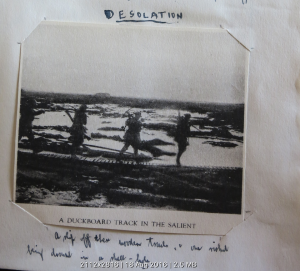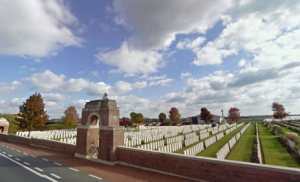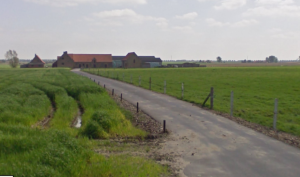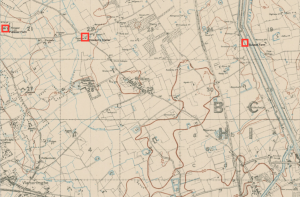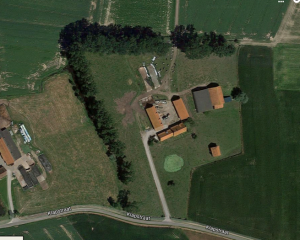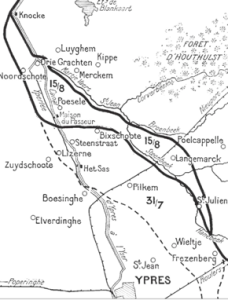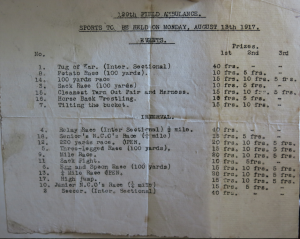Monthly Archives: August 2017
30th August 1917 Thursday
All material produced or reproduced here and throughout this work is the sole copyright of the author and the family of Doctor D.C.M. Page MC
“On the 30th August the 51st Division marched into the trenches on our right. It was good to see the ‘Jocks’ again. On the same day I went up to Fusilier A.D.S. for duty, and had a busy night – twenty-two wounded being brought in. One man died. He had been lying out in a shell-hole in ‘No Man’s Land’ for ten days, and had a compound fracture of one thigh, and wounds in the legs, arms and back. We kept him alive for an hour on strychnine and oxygen.”
The 51st (Highland) was a division of territorial or reserve regiment, formed in 1908 after the re-organisation of the army. Arriving in Flanders in force during 1915, Haig considered them largely untrained and inexperienced in battle. This however gradually changed as time went on and the Division saw considerable action in Flanders and particularly on the Somme where they fought courageously to capture Beaumont Hamel, taking 2000 German prisoners. They had fought successfully at Pilkem and taken positions in advance of the Steenbeck River, a small stream with steep sided banks that was swollen with the recent heavy rain. They would continue to perform heroically until the end of the war.
The ADS at Fusilier was in the process of being whitewashed when Douglas arrived for duty, where he was kept busy with a steady stream of wounded being brought in.
The unfortunate chap that had lain alive for ten days in a shell hole is described by Douglas as being treated by strychnine and oxygen. The use of this treatment had become popular in the later part of the 19th century. It was used to treat pneumonia and was thought to induce stimulation to the muscles and cause convulsions. It was also being used as a performance stimulant by some athletes. Its use here maybe was to try and stimulate the patient into recovery, however the use of strychnine a powerful and ultimately fatal poison possibly hastened his demise.
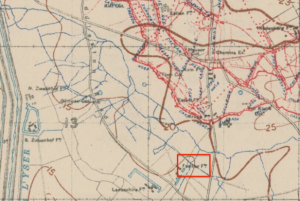
Fusilier Farm. Reproduced with the permission of the National Library of Scotland. https://maps.nls.uk/index.html
Find out about our connection with Dr Page and an introduction to his diary here
28th August 1917 Tuesday
All material produced or reproduced here and throughout this work is the sole copyright of the author and the family of Doctor D.C.M. Page MC
“As soon as daybreak arrived next day (28th) we began to get busy, as the wounded began to come in in large numbers. Practically all the wounds were caused by bullets, and we had several compound fractures of the thigh to deal with. It was a cold, wet day, and it was a pitiful sight to see the stretcher-bearers coming down the road from Langemarck with their many burdens, and the walking cases limping wearily along. The men were drenched to the skin, and shivering with cold. I was relieved at 9 o’clock that night, and was glad to get back to Pellissier Farm for a rest. I went down with a convoy of wounded and joined the Deckaville Railway at Gallwitz Farm. I didn’t get much sleep that night, however, as the Huns sent over a lot of high velocity shells near us.”
Find out about our connection with Dr Page and an introduction to his diary here
27th August 1917 Monday
All material produced or reproduced here and throughout this work is the sole copyright of the author and the family of Doctor D.C.M. Page MC
“At 1.55pm on the 27th, we and the 11th Division made an attack with the intention of advancing our line 200 yards. We had a wonderful view of the whole affair. The preliminary artillery barrage was a great sight, but the enemy replied very heavily and effectively about 3 minutes after our fire had commenced. However, we gained all objectives with the exception of a block-house in the cemetery well beyond Langemarcke, which was full of machine guns. The Huns attacked in mass formation later, and we had to retire to our original positions. The enemy lost heavily and so did we. The enemy snipers and machine guns did deadly work. Owing to the intense enemy shell fire, the wounded couldn’t be cleared. Of course the rain came on around 2 pm, and owing to this our planes couldn’t go up, and help the unfortunate infantry. It was bad luck on our men, and the Brigadier- General of the 115th Infantry Brigade didn’t help matters. They say he was hopelessly drunk all day. He came into our place after the show was over, and he certainly didn’t appear to be sober then. Of course, the heavy losses on our side might have affected him.”
Find out about our connection with Dr Page and an introduction to his diary here
25th August 1917 Saturday
Heavy casualties for both sides in the battle for Langemarck
All material produced or reproduced here and throughout this work is the sole copyright of the author and the family of Doctor D.C.M. Page MC
“On the 25th August Capt. Riddell and I were sent forward to Burnt Farm to establish an Advanced Dressing Station there. It was a cemented cellar in a heap of bricks in an exposed position on the eastern slope of the ridge. Not a healthy spot at all. The Steenbecque River was in front of us and Iron Cross – another extra hot spot, which the enemy shelled continuously – behind. I saw one of our aeroplanes have one of its wings blown off by one of our shells. Both aviators – young Canadians – were killed when the machine crashed close to us. The Engineers opened up an old enemy trench near us, and came across many dead Germans.”
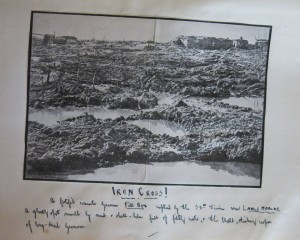
A fortified concrete German Pill Box captured by the 38th Division near LANGEMARCKE. A ghastly spot scarred* by mud and shell-holes full of filthy water and the bloated, stinking corpses of long dead Germans.
*editor’s interpretation
There were a number of so named Burnt Farms on the Western Front and there were two in the area around Ypres. This particular Burnt Farm was also known as the Cement House and is commemorated today with the Cement House Cemetery, maintained by the Commonwealth War Graves Commission.
Find out about our connection with Dr Page and an introduction to his diary here
22nd August 1917 Wednesday
A busy time in the skies
All material produced or reproduced here and throughout this work is the sole copyright of the author and the family of Doctor D.C.M. Page MC
“Wednesday, 22nd August, saw us busy with sick and wounded to attend to. The 11th Division on our right attacked at dawn, and were very successful. The tanks did good work. Air activity was great all day. The Huns crossed our lines in groups of seven and eight at a time, and at night lots of bombs were dropped all along the canal bank.”
The German planes had been active around the Ypres area from at least very early morning and had dropped bombs, scattered around local farms causing damage to civilians as well as military targets. Many horses were killed as well as farmers and of course soldiers. They would keep up activity throughout the day and then by 9.30 pm they set out in strength once more.
The use of tanks had become more widespread since the debacle experienced at the Somme, but as yet not with any great measure of success. By 3rd Ypres their use, although in much greater numbers was restricted to small groups. Many broke down or became stuck where the terrain proved too challenging and were abandoned before reaching their objectives.
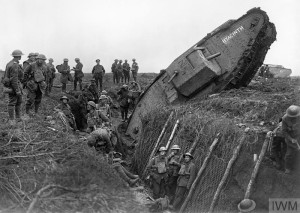
(Q 6432) A Mark IV (Male) tank ditched in a German trench. Some men of the battalion are resting in the trench, 20 November 1917. Copyright: © IWM. Original Source: http://www.iwm.org.uk/collections/item/object/205213173
Find out about our connection with Dr Page and an introduction to his diary here
20th August 1917 Monday
Train trip to Pilkem Ridge
All material produced or reproduced here and throughout this work is the sole copyright of the author and the family of Doctor D.C.M. Page MC
“Next day I had a tour of inspection ‘up the line’, going off early – 5 a.m. – in order to get comparative peace from shell fire. I went off with two N.C.O.s up the train-line to Stray Farm. There we got on to the main Pilckem-Langemarche Road and visited Cork House and Burnt Farm. We came back down the road to Pilckem Village – a heap of broken bricks and rubble. At Corner House – an excellent concrete dug-out in a notoriously hot spot for shell-fire – was an Advanced Dressing Station. The ground was a mass of shell-holes hereabouts, and it didn’t look a healthy spot at all. We returned to the canal bank via the duck-board track. The desolation and ruin up there was ghastly to behold. There were still lots of dead Germans lying about in shell-holes – distended, bloated corpses which stank horribly.”
The 60 cm trench tramway that ran past Stray Farm was not included in the maps of April 1917 but by the end of June an extensive network existed. The map below shows the route of the tramway that Douglas and his men took that day.
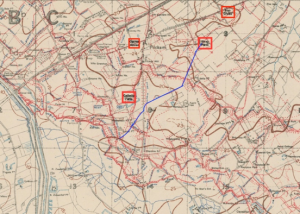
The blue line traces the route of the tramway. Points are highlighted in the red squares. Reproduced with the permission of the National Library of Scotland. https://maps.nls.uk/index.html
Find out about our connection with Dr Page and an introduction to his diary here
19th August 1917 Sunday
All material produced or reproduced here and throughout this work is the sole copyright of the author and the family of Doctor D.C.M. Page MC
The prevailing wind at the time had been a brisk westerly, which had apparently favoured the Germans. This was given as a reason as to why repaired machines were prevented from re-joining the action at the front and also why the RFC were not able to be as effective as required. Haig was in conference with many of his general staff and tried to encourage the different services to provide as many fit men to fight in the lines as possible. Also, to get existing men to work and fight for longer hours to make up for sustained losses.
A Catholic priest only a couple of miles to the south remarked that at 9.30 pm an entire squadron of German planes flew over laden heavy with bombs, with engines roaring under the strain. Artillery and guns from the ground fired angrily at the “Birds of Death” which hurriedly scattered bombs all around.
“Sunday 19th August was fairly quiet. Being a lovely, clear, sunny day aerial activity was very great. 42 of our planes were up at one time. It was a wonderful sight, until two were shot down in flames by German guns. The Hun planes were never in evidence during the day, but he flew over in force every night, and we could hear the bombs crashing all around.”
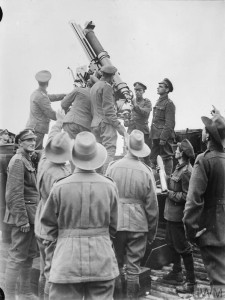
(E(AUS) 757) Australian troops watching British soldiers manning an anti-aircraft gun at Morbecque. Copyright: © IWM. Original Source: http://www.iwm.org.uk/collections/item/object/205193425
Find out about our connection with Dr Page and an introduction to his diary here
18th August 1917 Saturday
All material produced or reproduced here and throughout this work is the sole copyright of the author and the family of Doctor D.C.M. Page MC
“On Saturday, August 18th, we were up at 3.30 a.m. and after breakfast marched off to Pellissier Farm near Dawson’s Corner. It was a long and tiresome march. After a meal Capt. Burke and I proceeded in an ambulance car to Sussex Advanced Dressing Station on the canal bank, where we took over from the 61st Field Ambulance. We had a busy night attending to wounded. Over 60 cases came in. They had to be dressed, fed and then despatched by ambulance car to the rear.”
The area to the south of the town of Ypres was this day comparatively quiet, with little shelling compared to the previous days. Rumours from retreating troops and women working in the laundries for the allies told how the British had taken Langemarck and pushed on through Polygon Wood towards Zonnebeke. Here the advance came to an abrupt halt. Taking the British by surprise the Germans were to muster a fierce counter-attack, inflicting heavy casualties. The British had lost communications with their own artillery, and got caught in their own barrage. Something like 6000 casualties were suffered and despite taking hundreds of German prisoners, the British had to abandon the advance and retreat once more.
Field Marshall Haig however, had enjoyed a good lunch back at his HQ and then went by motor car to Camiers on the coast near Etaples to watch a display of machine gun fire. He also took the time to record how he felt the French air service was in a poor state of moral and discipline, also feeling that a “considerable number of (French) pilots, didn’t mean business when they go out!”
Find out about our connection with Dr Page and an introduction to his diary here
16th August 1917 Thursday
Injured German Soldier is handed over for treatment
All material produced or reproduced here and throughout this work is the sole copyright of the author and the family of Doctor D.C.M. Page MC
“On the 16th August the French and British attacked again in fine weather, and took all objectives, including Langemarcke, with the capture of lots of prisoners and guns.”
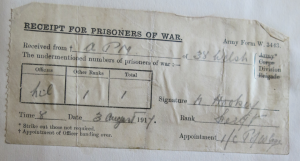
Sgt. N. Hookey gives a receipt for one German Prisoner of War captured in the battle for the Ypres Salient on 3rd August from the PoW cage probably at Mordacq Farm.
The Battle for Langemarcke officially lasted for three days and concluded on the 18th. It was yet another temporary success for the allied forces, but seemed significant at the time.
Find out about our connection with Dr Page and an introduction to his diary here
13th August 1917 Monday
All material produced or reproduced here and throughout this work is the sole copyright of the author and the family of Doctor D.C.M. Page MC.
An old school pal visits and a fun day with the 129th Field Ambulance
“My school-mate – James Dandie – paid me a surprise visit on the 13th. He had ridden all the way from Zillebeeke, and was looking very fit.”
A bit of an aside to the diary but I couldn’t resist
It wasn’t all terror and tragedy at the front, occasionally some light relief was organised behind the lines. Not quite as far behind as Douglas Haig and his staff though.
We mentioned old pal James Dandie when they met up last year. http://whiz-bangskrumpsandcoalboxes.co.uk/2016/07/18/18th-july-1916-tuesday/
I wonder if Jim entered the sports day?

James Naughton Dandie went on to become President of The Law Society of Scotland. Photo courtesy of The Law Society of Scotland
Find out about our connection with Dr Page and an introduction to his diary here
